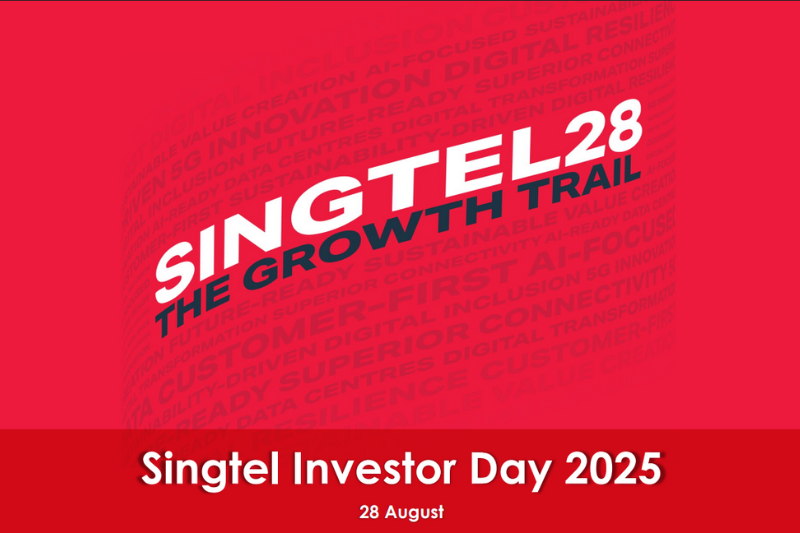Several Singapore blue-chip companies have been updating their shareholders annually on the progress and status of their long-term goals.
Singtel (SGX: Z74) is one of them.
Singapore’s largest telecommunication company (telco) recently released its presentation slides for its latest Investor Day event, which details the group’s strategies and long-term objectives for 2028 (ST28).
Investors can check out last year’s Investor Day 2024 if they are interested in finding out more about the progress of these goals.
Here are five things that investors need to know about Singtel’s long-term plans.
Strengthening its Singapore core
With Singapore as the core of Singtel’s base, the plan is to enable this division to return to revenue growth.
Singtel also has industry-leading EBITDA* margins of 39%, higher than Australia’s 37% and Japan’s 28%.
The next step is for Singtel Singapore to lead industry transformation by differentiating itself through network performance and service quality.
At the same time, the division will build scalable software-defined platforms and invest in dual-stack global infrastructure.
Artificial intelligence (AI) will be at the core of this transformation.
The division intends to return to both revenue and EBITDA growth by 2028, with plans to grow its international revenue by 1.5 times.
Hyper-personalisation is on the cards as Singtel seeks to deliver the right offer to the right person, and AI agentic care will take care of 95% of interactions.
Its ST28 ambition is to maintain EBITDA margins above 35% and witness a revenue compound annual growth rate (CAGR) of 20% for its growth engines.
*EBITDA = Earnings before interest, taxes, depreciation and amortisation
Consumer market to drive growth in Australia
Over at Optus, management also laid down bold plans.
The Australian telco is the #2 telco in the country and provides customers with more than 12 million services every day.
The division reported solid performance for the first quarter of fiscal 2026 (1Q FY2026) ending 30 June 2025.
Revenue rose 4% year on year to A$2 billion while operating profit climbed 36% year on year to A$133 million.
Optus intends to leverage its consumer network to drive growth for FY2026.
To this end, the division has partnered with Perplexity AI to offer Perplexity Pro and execute price rises across its prepaid and postpaid services in 1Q FY2026.
In the enterprise segment, Optus is expanding its channel and distribution strategy while simplifying its systems and processes.
The division will be guided by five key themes for the long term – strong foundations, business simplification, flexible & modern architecture, core revenue growth, and a restructured cost base.
AI as the pillar of growth for NCS
NCS has a headcount of more than 13,000 with >4,000 active projects.
The provider of IT services continues to grow along three axes – industry diversification, services evolution, and geographic expansion.
The division achieved a revenue CAGR of 9% from FY2022 to FY2025, with new business achieving a revenue CAGR of 18% over this period.
For 1Q FY2026, operating profit jumped 22% year on year to S$79 million, and bookings stood at S$732 million.
The division sees three key AI catalysts that can boost its revenue and profits in the coming years.
The first is intelligentisation, which embeds intelligence into business processes and government workflows.
The second is internationalisation, which involves the enablement of regional AI capabilities and deployments.
Finally, there is inspiration, which utilises AI to uplift people and build hyperlocal technology.
A bright data centre future
Next, Singtel intends to grow its digital InfraCo and Nxera division.
The colocation data centre market size for regional markets is projected to grow by a 14% CAGR from 2025 to 2028 to end at US$7.45 billion.
Singapore will form the bulk of this market at US$5.2 billion, but other markets such as Johor and Bangkok will witness a CAGR of 28% and 26%, respectively, albeit off a low base.
Nxera aims to increase its data centre total gross capacity to more than 400 MW by 2028, with an interim target of hitting >200 MW by the end of next year.
The division is on track to deliver revenue CAGR of more than 20% from FY2026 to FY2029, along with more than S$300 million of EBITDA by calendar year 2028.
Associates to help drive further growth
While Singtel works to drive its core divisions, investors should not forget about the telco’s associates.
If these associates perform well, they can contribute to a higher share of profits that will help to lift the group’s total net profit.
For Airtel, its growth strategy is to drive mobile ARPU (average revenue per user) via 4G and postpaid upgrades.
For AIS in Thailand, it will focus on quality mobile subscribers via upselling and 5G services, while offering differentiated content bundle offerings.
Telkomsel in Indonesia aims to expand its 5G network and drive mobile ARPU from product simplification, pricing, and channels.
Finally, for the Philippines’ Globe, it will focus on delivering high-value enterprise ICT solutions.
Get Smart: On track for low double-digit ROIC
Singtel’s message is clear – the telco will work on multiple fronts to lift its business performance and strive to achieve low double-digit ROIC in the mid-term.
For FY2026, the group provides a sanguine outlook with operating profit projected to grow by high single digits, accompanied by annual cost savings of S$200 million.
Singtel is also committed to growing shareholder returns, and its total dividend for FY2025 has already more than doubled from S$0.075 in FY2021 (before its strategic reset) to S$0.17.
The telco also has a value realisation share buyback programme to provide sustained value creation, with up to S$2 billion committed to buying back shares.
Singtel’s mid-term capital recycling target stands at around S$9 billion, which will be used to fund its value realisation dividend, share buybacks, and to fund growth initiatives.
Explore Singapore’s top “evergreen” stocks with our FREE report. It spotlights 7 Singapore blue-chip stocks with solid dividends and growth potential. Click here to download it now to create a flow of dividend income, regardless of market conditions.
Follow us on Facebook, Instagram and Telegram for the latest investing news and analyses!
Disclosure: Royston does not own shares in any of the companies mentioned.






